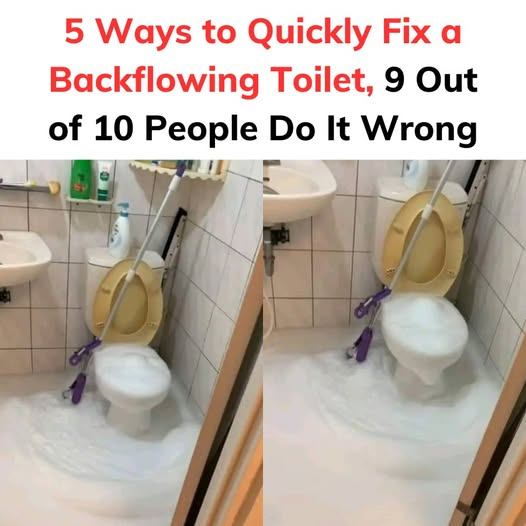ADVERTISEMENT
How to Use a Plunger Effectively:
- Get the Right Plunger: For toilets, you’ll need a flange plunger (with an extended rubber flange) as it creates a better seal and is more effective.
- Position the Plunger: Place the plunger into the toilet bowl, ensuring the rubber flange is fully submerged in water.
- Pump Up and Down: Start pumping the plunger up and down vigorously but slowly, creating suction to dislodge the blockage.
- Flush: After 10-15 plunges, try flushing the toilet to see if the water drains properly. If the clog is cleared, you’re good to go!
2. Try a Toilet Auger
If the plunger doesn’t do the trick, a toilet auger (also known as a plumbing snake) can help. This tool is ideal for reaching deeper clogs in the toilet trap or drainpipe that a plunger can’t clear.
How to Use a Toilet Auger:
- Insert the Auger: Carefully insert the auger into the toilet bowl and push it down into the drainpipe.
- Turn the Handle: Twist the handle of the auger to extend the coiled wire into the pipe. The auger will latch onto the clog.
- Dislodge the Clog: Keep turning the handle to either break up or pull the clog out. If you feel resistance, you’ve likely reached the blockage.
- Flush: Once the clog is dislodged, flush the toilet to ensure everything flows smoothly.
3. Use Baking Soda and Vinegar
For a less traditional method, baking soda and vinegar can help break down clogs and clear a backed-up toilet. The chemical reaction between the two can help dissolve organic matter causing the blockage.
How to Use Baking Soda and Vinegar:
- Pour Baking Soda: Pour about 1 cup of baking soda directly into the toilet bowl.
- Add Vinegar: Slowly add 2 cups of vinegar into the bowl. The mixture will fizz and bubble.
- Let It Sit: Allow the mixture to sit for 30 minutes. The fizzing action can break down the clog.
- Flush: After waiting, flush the toilet to see if the water drains properly.
If the clog is not cleared with this method, try it again or move on to the next solution.
4. Check for Main Sewer Line Blockages
If the toilet keeps backing up even after trying to clear the clog, the problem may be in the main sewer line, which requires more attention. Blockages in the main sewer line can cause backups in multiple toilets and drains in the home.
How to Check for Sewer Line Blockages:
- Check Other Drains: If you notice slow drains or a backup in other sinks or tubs, this is a clear sign of a sewer line issue.
- Call a Professional: Sewer line clogs can be complex and often require professional intervention. If you suspect a problem with the main sewer line, contact a plumber to inspect the line and clear the blockage.
5. Turn Off the Water Supply and Prevent Further Backflow
If your toilet is actively overflowing and the above methods aren’t effective, you should immediately prevent further backflow to avoid water damage.
How to Stop the Water Supply:
- Locate the Water Supply Valve: Behind your toilet, there should be a small valve near the base of the toilet tank.
- Turn Off the Valve: Turn the valve clockwise to stop the flow of water into the toilet tank. This will prevent any further overflow.
- Clean Up: Use towels or a mop to soak up any water that has overflowed onto the bathroom floor. It’s important to act quickly to prevent water damage.
Once the water is turned off and the overflow is contained, you can proceed with the clog-clearing methods above at your own pace.
Preventing Future Backflows
Once you’ve dealt with the immediate issue, consider taking steps to prevent future backflows:
- Regularly Clean Your Toilet: Regular cleaning can help prevent buildup in the toilet’s drainpipe and traps.
- Avoid Flushing Non-Flushable Items: Be mindful of what you flush—avoid flushing paper towels, wipes, or hygiene products.
- Schedule Regular Maintenance: If you have an older toilet or plumbing system, consider scheduling periodic plumbing inspections to catch potential issues before they cause backups.
Conclusion
A backflowing toilet is never a fun situation, but with the right tools and a little know-how, you can fix it quickly and prevent further damage. Whether you start with a plunger, use an auger, or rely on some natural cleaning solutions like baking soda and vinegar, there are multiple ways to tackle the issue. If all else fails and the problem seems bigger than a simple clog, don’t hesitate to contact a professional plumber to avoid complications down the road. With these quick fixes, you can have your toilet back to normal in no time!
ADVERTISEMENT
